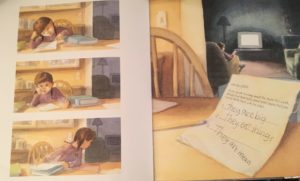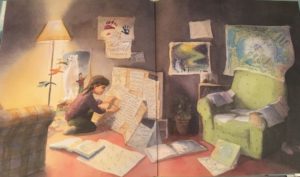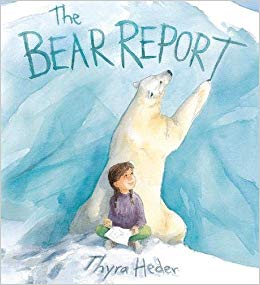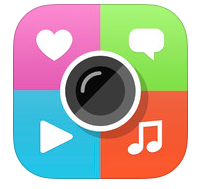Why I Picked It Up: My two-year-old picked this one up in our latest weekly trip to the library. My force of nature typically sweeps through the library grabbing books at will from the shelf, and most of them find their way back to the reshelve cart. Fortunately, I glanced through this one before I gave it back!

Why I Finished It: I immediately identified with the first page of The Bear Report! It starts with a homework assignment to list three facts about polar bears that a little girl, Sophie, intends to share with her class. However, she is clearly not enthused by this assignment and it isn’t long before she scribbles down her three facts and rushes into the living room to watch TV. Sophie receives quite a shock when she is joined by a polar bear in her living room to challenge her “research.” The polar bear introduces himself (Olafur) and takes Sophie to give her personal tour his habitat.

Olafur knows what we, as teachers, also know – the best way to help a student become interested in a subject is to bring it to life! They take an imaginary adventure to the snow-covered landscape and she spends a day in the life of a polar bear, hunting fish, talking to whales, playing, swimming, and being immersed in Olafur’s world. In the end, Sophie makes a complete 180-degree shift and the readers can see exactly what happens when students get excited about learning!
The watercolor illustrations in The Bear Report are gorgeous and contribute to the dream-like feel of Sophie’s adventure. The back-and-forth conversation between Sophie and Olafur easily imparts facts and information about polar bears that will have kids (like mine!) anxious to learn more!
Who I’d Give It To: Elementary teachers are the obvious choice, but this is a great read-aloud at the beginning of a research unit on any topic!
Integration Ideas
Sparking Curiosity
The Author’s Note in the back of The Bear Report talks about Thyra Header’s own trip to Iceland, and this quote perfectly embodies the spirit of this book: “What at first had felt like nothing but ice now seemed to have a personality, a heartbeat.” This is what we want for our students! We want whatever they’re learning about to come alive for them!
The Bear Report is full of a little bit of information about a lot of different things related to the Arctic: obviously polar bears, but also whales, seals, arctic foxes, glacier mice (my personal favorite!), the Northern Lights, and more. There is plenty of material here spark the curiosity of a wide variety of students. It’s all about the Arctic, but within that umbrella of a topic, there are many subtopics that students can choose from. Maybe they aren’t interested in polar bears, but the whales catch their interest. Perfect! Now they have a research topic that is meaningful and engaging!
There are many ways to “cast a wide net” that can help students discover what they want to learn about.
Images
- Infographics. These images are almost too stimulating, but they provide such a wide variety of visual interest that each student is sure to find something that appeals to them. Kids Discover is a great place to start.
- News sites. USA Today has Snapshots (small infographics), CNN, National Geographic, New York Times, and NASA all post a “Photo of the Day,” and most news sites or organizations have some kind of daily or weekly image that can relate to a current event or some place in the world (or out of it!) that is new and exciting. Note: due to the variety of things that happen in our world on a daily basis, make sure you check the image the day you plan to show it, just to be sure!
- National and state libraries. These libraries are incredible repositories for historical images and artifacts from many different time periods. Be sure to check out the Library of Congress, the National Archives, and your state library archives. They have extensive educator resources in addition to their collections of visuals.
Virtual Field Trips
Virtual field trips are another great way to immerse students in a topic to help it come to life!
- Interactive, self-guided tours. These “tours” typically offer a floor plan of a building or area and certain areas of that place contain pop-ups with information and images.
- 360 videos or photos, panoramic photos.
- http://www.thealamo.org/visit/grounds/virtual-tour/index.html
- Experience the Blue Angels in 360-degree video: https://www.youtube.com/watch?v=H6SsB3JYqQg
- More 360-degree videos are available on YouTube’s 360 Video Channel: https://www.youtube.com/channel/UCzuqhhs6NWbgTzMuM09WKDQ
- Google Street View. Tap into the extensive visual content that Google offers from around the world! Observe the architecture, transportation, weather, clothing, and immerse yourself in the culture as you actually “walk” through the streets of wherever you want to go. A majority of the imagery is exterior, but more interior imagery from famous buildings and landmarks is being added.
- Video Conference. These events happen in real time and allow for real-time interaction as well. Many popular museums and organizations offer this type of service (many times at no cost) and will present an educational program based for the students. Authors like to connect with classes in this way as well. Work with students ahead of time to spark curiosity so they will be engaged in the program!
- Skype with organizations: https://education.microsoft.com/findalesson/virtualfieldtrip
- Skype with other classrooms: https://education.microsoft.com/skypeintheclassroom
- View archived video conferences or sign up for live events: http://www.discoveryeducation.com/Events/virtual-field-trips/explore/index.cfm
Habitat Research
Maybe you’re studying the Arctic region as a habitat. Maybe you’re just beginning a study of biomes. The Bear Report can serve as a template for the types of things you might need to research to get a complete picture of a place. As you read the story together, make a list of the types of things Sophie and Olafur cover: food, predators, prey, landscape, etc.
Research the biome or habitat as assigned. Here a few great animal research sites:
- https://kids.nationalgeographic.com/
- https://kids.sandiegozoo.org/animals
- https://www.worldwildlife.org/
Thinglink is an excellent way to display this type of research. It allows you to display an image in the background an attach textboxes, links, videos and other multimedia to specific parts of the image in order to provide more information on that part of the image. Check out this post for more about how to use Thinglink.
Here’s an example of a polar habitat: https://www.thinglink.com/scene/764197317279481856
Imaginative Writing
The Bear Report is a unique cross between fiction and nonfiction. Obviously, a polar bear can’t really talk, but the book does convey a lot of information. After students have researched their habitat or a specific animal they are interested in, they will have all the information they need to write a similar story. What animal would they want to encounter in their living room? What animal would they want to spend the day with? Where would they go? What form of transportation would they need to get there? What would they see? What other animals would they encounter and what would those animals think about them? What would they eat? How would that animal talk? What kinds of misconceptions do people have about that animal and how might that animal correct those?









Leave a Reply